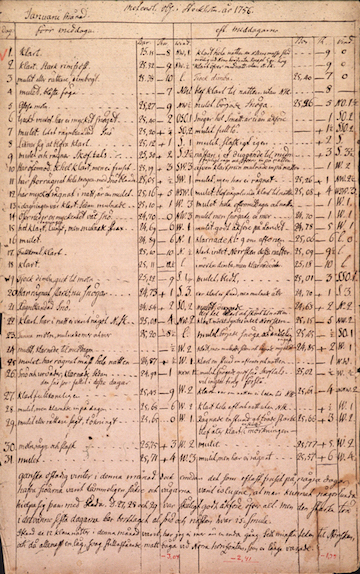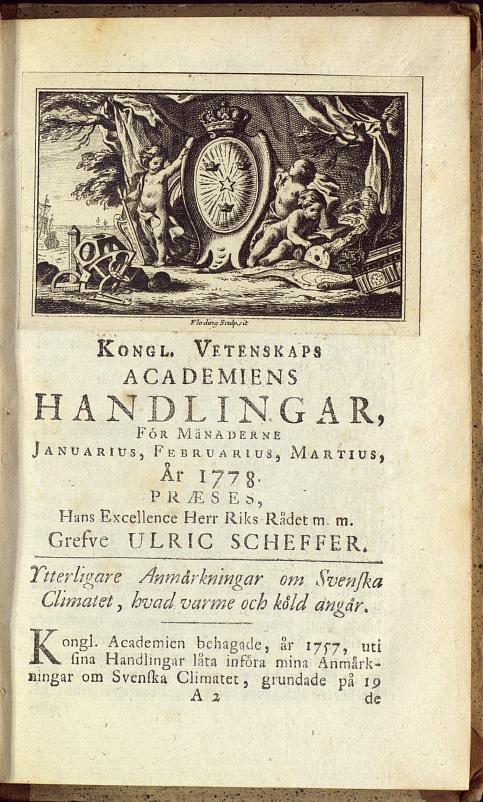- Black curve
- Long-term average (1756−2005) daily mean temperature for each calendar date.
- Red/blue curve
- Daily mean temperature for each date in a selected year.
- Grey band
- Range between highest and lowest recorded daily mean temperature for each date, within the first 250 years of data.
Datasets
Background
Early meteorology in Sweden
In the eighteenth century, during the Enlightenment, it was common that astronomers carried out weather observations as the science topic today known as meteorology was not yet born. In Sweden, the earliest instrumental weather observations were made in Uppsala in 1722. Anders Celsius (1701–1744), now most famous for his thermometer scale presented in 1742, was involved in making these first measurements already when he was a young student at the university and he continued with making weather observations in Uppsala for many years. Thanks to Celsius’ work, temperatures in Sweden have been measured in the Celsius scale already since the 1740s.
Pehr Wargentin — father of the weather observations in Stockholm
In 1735 another young person, Pehr Wilhelm Wargentin (1717–1783), registered as a student at the university in Uppsala to study mathematics and astronomy. Wargentin assisted Celsius in the making of both weather and astronomical observations. In 1746 Wargentin presented a thesis based on his studies of planet Jupiter’s moons.
After Wargentin had been elected as the secretary of the Royal Swedish Academy of Sciences in 1749, he became engaged in planning for the construction of an astronomical observatory in Stockholm. The building was inaugurated in 1753. Wargentin became the director and immediately moved into apartments in the middle storey, where he lived for the rest of his life.
Pehr Wilhelm Wargentin (1717–1783)
Astronomer. Secretary of the Royal Swedish Academy of Sciences. The first director of the astronomical observatory in Stockholm. He initiated the long weather observations series there. Image from Wikimedia. Public Domain.
Stockholm observatory in 1784
Sweden’s first air balloon ascent was made at the Stockholm observatory in September 1784, in presence of King Gustav III.
Pehr Wilhelm Wargentin lived on the second (middle) floor. His thermometer was probably placed outside the window seen to the left, about 5.8 m above ground on the wall facing north (towards the artist). His barometer was probably placed in the building extension on the ground floor, directed towards east. The original document is available at the Centre for History of Science. Image from Instagram. Photo courtesy of J. Häggblom.
The duties of the academy’s secretary were plentiful, ranging from being the responsible editor of the academy’s transactions to finding financial support for buying and manufacturing instruments at the observatory and to laying out plans for various scientific investigations. Wargentin discussed with his colleagues about the best way of conducting weather observations and he argued for the introduction of standardized routines. On January 1, 1754, Wargentin started to keep a diary of weather observations made at the astronomical observatory in Stockholm and he continued to make these observations himself almost every day until he died on December 13, 1783.
Wargentin’s scientific work as a climatologist
Wargentin wrote seven articles with topics related to meteorological instruments, weather and climate, which were published in the academy’s transactions between 1749 and 1778. This set of articles provides a good view of how well, or little, scientists of those days understood climate and weather phenomena. In the first of these papers he discussed different thermometer types that were in common use at the time. He judged the Swedish type, made by Celsius and other colleagues, to be the most reliable. This probably explains why the Celsius type rapidly became the standard in Sweden.
In the last of the seven articles, Wargentin analysed his own temperature observations made in Stockholm during 1758–1777 together with observations in Uppsala from 1739–1757. He was able to demonstrate that a common belief of those days that climate repeated itself every nineteenth year was a false idea. Hence, he demonstrated the efficiency of scientific methods for testing a hypothesis. He also stressed the importance of undertaking more observations to help scientists to better understand nature’s rules.
Wargentin’s weather observation diary, January 1756
Already from the beginning, temperature was measured in degree Celsius. The height of the mercury column at the barometer was measured in Swedish inches (29.69 mm) and wind speed was reported in a scale from 0 to 4. The original document is available at the Centre for History of Science. Unknown photographer.
Further remarks on the Swedish climate, concerning heat and cold
Front page of Wargentin’s article in the transactions of the Royal Swedish Academy of Sciences, 1778, vol. 39, p. 3–19. The original document is available at the Centre for History of Science.
From Wargentin to SMHI
After Wargentin had died, another astronomer, Henric Nicander (1744–1815), took over the role as the academy’s secretary and also the task of doing weather observations. Later, observing the weather became regarded as a simple routine work and the job was left to other staff such as attendants and caretakers. Scientists at the academy became more engaged in planning for the establishment of a national network of weather observing stations.
Largely as a result of the academy’s efforts, the first successful Swedish national network of weather stations on land, with about 25 stations, was established in 1859. About a decade earlier, another network with weather observations being made at about 15 lighthouse stations had been established by marine authorities. Together, they were the start of the modern network of several hundred weather stations managed by the Swedish Meteorological and Hydrological Institute (SMHI).
Stockholm observatory — a unique long-term weather observing station
The old astronomical observatory in Stockholm is one of the stations in the SMHI network and measurements there have always been made at the same geographical location. The World Meteorological Organization (WMO) acknowledged in 2017 this site as a long-term observing station, implying that it is considered as highly important for climate science due to its long-term sustainable observational standards and high-quality time series data. Stockholm has the longest record among all the WMO long-term stations.
Long weather record — challenge for climate scientists
Much, however, has happened during the more than 260 years that have passed. Not just has climate changed and become warmer, but also observation routines, instruments and their exact positions have changed (since 1961 at 59°20'30.1"N, 18°03'17.6"E, 44 m a.s.l.). The local environment has also changed as Stockholm has grown from being a rather small city having a few hundred thousand citizens to a large urban area with more than a million people. This has led to a local warming since the middle of the 19th century due to the so-called urban heat island effect. Thus, it is a challenge for scientists to use the hundreds of thousands of individual observations to obtain so-called homogeneous data series; i.e. data that only show how weather and climate has varied.
Scientists at Stockholm University have studied how to derive homogeneous daily air temperature and air pressure data for Stockholm back to 1756. This work started with a doctoral thesis in Physical Geography (Moberg, 1996) and continued in projects done together with scientists in other European countries having similar long-term daily instrumental weather records and with colleagues at Uppsala University and the SMHI (Moberg et al., 2002; Moberg et al., 2003). The dataset presented here is based on the outcome from that work and has been updated to the present by merging with recent data from the SMHI resource Öppna Data.
Map
Citation
Anders Moberg (2021) Stockholm Historical Weather Observations. Dataset version 4. Bolin Centre Database. https://doi.org/10.17043/stockholm-4
References
Moberg A. 1996: Temperature variations in Sweden since the 18th century. Avhandlingsserie / Naturgeografiska institutionen, Stockholms universitet, 1104-7208 (5)
Moberg A, Bergström H, Ruiz Krigsman J, Svanered O. 2002: Daily air temperature and pressure series for Stockholm (1756–1998). Climatic Change 53: 171–212. https://doi.org/10.1023/A:1014966724670
Moberg A, Alexandersson H, Bergström H, Jones PD. 2003: Were Southern Swedish summer temperatures before 1860 as warm as measured? Int. J. Climatol. 23: 1495- 1521. https://doi.org/10.1002/joc.945
Comments
Version history
Version 4
Monthly mean air temperatures updated to 2020.
Version 3
Data re-organized into one collection with the different data types being separated into individual datasets and with data updated as follows:
Temperature — Monthly mean air temperatures 1756 – 2019. Daily mean air temperatures starting in 1756 with live daily updates to the present. Individual thermometer observations 1756 – 2018.
Pressure — Barometer observations in original units 1756 – 2018. Sub-daily sea level pressure 1756 – 2012.
Cloud — Sub-daily cloud amount 1756 – 2018.
Snow — Maximum snow depth in each winter from 1904/05 to 2018/19.
Observation times — Information about the time points when weather observations were made each day (morning, noon, evening), as used for calculation of daily mean temperatures, during 1756 – 2018.
Version 2
Same data structure as in version 1, but with data updated to 2017.
Version 1
Initial release. Provided as a single dataset containing temperature, air pressure, cloud, snow and observation times data. Most of the data files end with 2016.
Contact information
Email address
[javascript protected email address]Phone number
+46 8 674 78 14
Postal address
Anders Moberg
Department of Physical Geography
Stockholm University
SE-106 91 Stockholm Stockholm
Sweden
GCMD science keywords
Earth science > Atmosphere
GCMD location
Continent > Europe > Northern Europe > Scandinavia > Sweden
Status
Completed
Dataset language
English
Project
Digitization, quality control and development of daily and monthly air temperature and pressure data series until 1998 was undertaken as part of the project IMPROVE - Improved Understanding of Past Climatic Variability from Early Daily European Instrumental Sources. Project funding: EU 4th Framework Programme, 1998–1999. Contract: ENV4-CT97-0511. Co-ordinator: Dario Camuffo, Consiglio Nazionale delle Ricerche, Istituto di Scienze dell'Atmosfera e del Clima, Padova, Italy. PI at Stockholm University: Anders Moberg. Development of sub-daily cloud amount data files until 2000 was made by Anders Moberg as part of a project funded by the Office of Science, US Department of Energy, under grant no. DE-FG02-98ER62601. PI: Philip Jones, Climatic Research Unit, University of East Anglia, UK.
Publisher
Bolin Centre Database
Begin date
1756-01-01
Dataset version
4
Use limitations
None
DOI
10.17043/stockholm-4
Published
2021-02-11 12:23:24
Revisions
Version 4
2021-02-11 12:23:24



